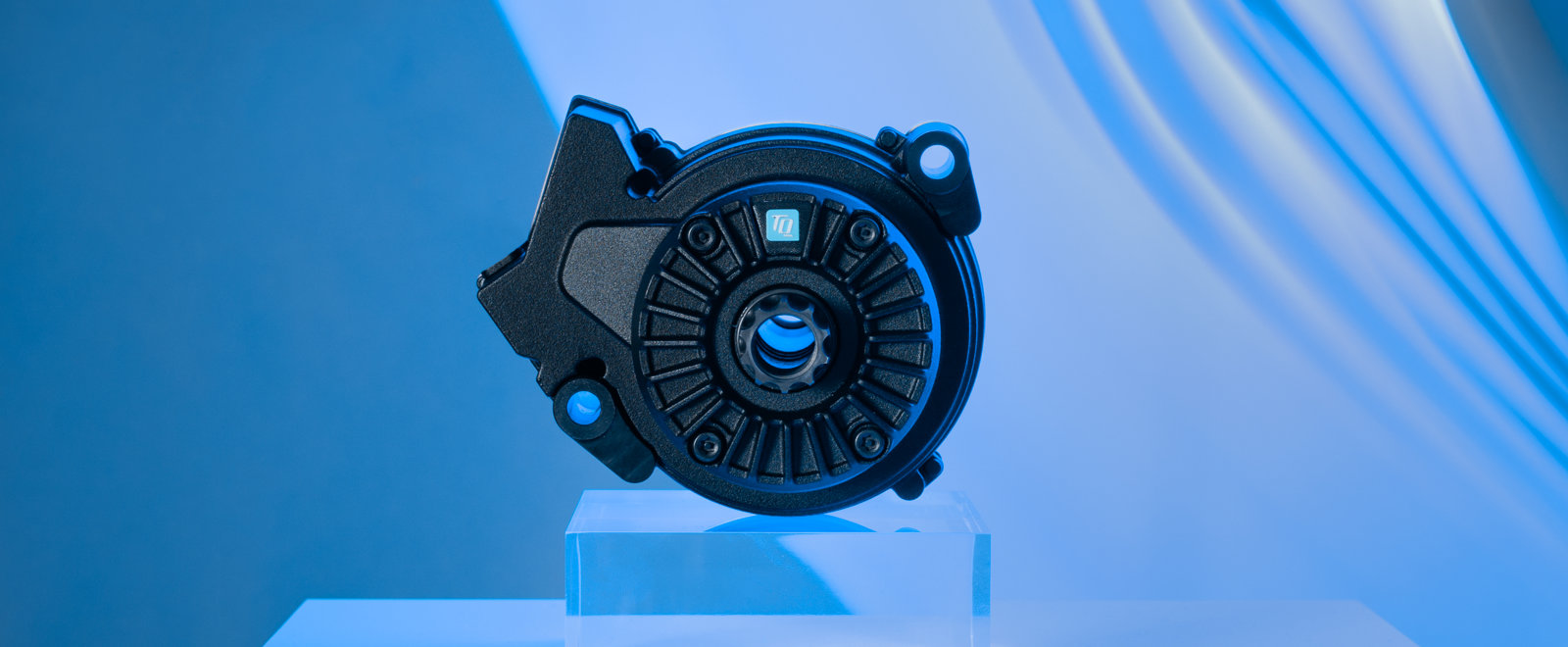FAQ – TQ-E-Mobility All you need to know about the TQ HPR® 120S
In the following we have briefly and concisely summarized the answers to many frequently asked questions (FAQ). The answers are arranged according to topics and products. If your question is not listed, please feel free to contact us directly at any time.
How does the harmonic pin ring gear work?
It is a completely new TQ technology. Two gears – one internal and one external – sit on a central axis and are positively connected to each other by a flexible transmitter called a pin ring.
The force is transmitted from one gear to the other via the pins of the transmitter. Due to a special tooth geometry and the elastic deflection of the transmitter, it is possible for all pins to engage simultaneously on all teeth. The pressure on any single tooth or pin is therefore very low. This means that the gearbox can be designed to be extremely compact, has a very high degree of efficiency due to the low surface pressure on the teeth, and is maintenance-free.
What is special about the TQ HPR® 120S actuator?
Its power, its comfort and its range! It is currently the only serially produced mid-engine with similar torque and power, and stands out clearly from all other drives, yet it is very small in size. It therefore has an enormously high torque density.
And its round design is rotationally symmetrical around its integrated bottom bracket axle. This gives the vehicle manufacturer maximum freedom in terms of frame design.
How long can the drive deliver its torque?
The drive can deliver its 120Nm always and constantly. It is not a peak value, it can do this permanently over the complete cadence range.
How does so much force affect the vehicle?
Even at the highest support level, the TQ HPR® 120S drive is easy to control thanks to its special motor control. The high torque enables extremely comfortable and relaxed driving even at low speeds and cadence frequencies, while the high performance also meets all requirements such as powerful and fast acceleration, sporty driving and (high speeds) steepest climbs.
An intelligent sensor system integrated into the engine control system for interrupting gear shifts (not to be confused with switch recognition) enables fast and convenient gear changes and eliminates the load peaks on the chain, belt and gears that are otherwise common with e-bikes, which significantly increases their service life.
Why can the TQ HPR® 120S deliver such high torque?
The trick is its patented harmonic pin ring transmission. With standard gear units, the force is usually transmitted through 1-3 meshing teeth, the majority of teeth are usually not meshed. This results in a significantly less efficient and indirect power transmission. The gear usually swallows most of the installation space in central drives. With the harmonic pin ring gear, all teeth of the gear are meshed simultaneously and are used for the power transmission, so that the gear can be designed much more compactly and still effortlessly map the necessary reduction ratio (currently 1:37) in only one gear stage. Standard gear units require at least three gear stages for this.
Are there other gearboxes that can do the same?
No. In robotics in particular, there are other rotationally symmetrical gears, also with high reduction in one stage (e.g. cycloidal or harmonic gears). Their use, however, always requires at least one or more limitations such as:
- Significantly lower efficiency
- No or only small hollow shaft (otherwise usable installation space around the central axis)
- Wide axial design
- High cost
- The harmonic pin ring gear is not subject to these limitations.
How efficient is the TQ drive?
The system efficiency – from electrical input power at the motor to mechanical output power at the chainring – is over 80% and not only at the nominal point but over about two thirds of the power range.
Do I have to pedal the drive when driving without support?
No. The HPR® 120S works like on a normal bicycle when used without motor support. Specially developed sprag freewheels completely decouple the complete drive, including the gearbox.
How does the torque sensor work?
The torque curve produced by the rider's pedal stroke is very irregular (sinusoidal); the pattern is different from driver to driver and often also laterally different. This makes a useful determination of the input signal (and with e-bikes this is the crank) a great challenge.
The torque sensor in the TQ HPR® 120S is mechanically designed so that it can measure both torque and speed of the crank shaft independently of each other on both sides. By combining these input parameters with a specially developed algorithm, the drive can be controlled very finely and sensitively and at the same time also conveniently.
The mapping of the motor can be adapted to all requirements. For example, you can map a "sportive mode" with training factor – a mode that motivates the driver to make an effort.
The TQ HPR® 120S always does exactly what the driver expects from it.
